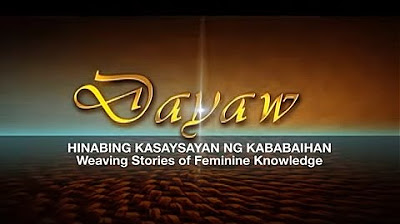Dayaw Season 3 Episode 1 - Hinabing Lakas
Summary
TLDRThe third season of 'Dayaw' delves into the rich tapestry of Philippine weaving traditions, showcasing the skill and resilience of indigenous weavers. From the use of natural materials like cotton, silk, and pineapple fiber to the backstrap loom technique, the series explores the cultural significance and artistic diversity of weaving. It also highlights the challenges faced by weavers and the efforts to preserve and promote this ancient craft, ensuring its place in modern times.
Takeaways
- 🌳 Traditional artisans and craftsmen use a variety of materials, from plant fibers to precious metals, to create cultural expressions.
- 🌟 The chosen materials of indigenous craftsmen embody their knowledge and culture.
- 📚 The first two episodes of the third season of Dayal focus on the fibers of distinct cultures and the resilience of the weavers.
- 🎓 Professor Norman SP's book 'Journey of a Thousand Shuttles' is a comprehensive guide to Philippine weaving traditions.
- 🕰️ The oldest material evidence of weaving in the Philippines dates back to 2600-2100 BC.
- 🌐 Southeast Asia has many weaving traditions, with the backstrap loom being a common technology used by various cultures.
- 👗 The backstrap loom is characterized by the weaver's body movements, which are integral to the weaving process.
- 🌈 The Kalinga people are known for their use of ground with young airing bone design and similar color schemes to other cultures.
- 📏 The Yakan people of Basilan are renowned for their dense, tightly woven fabrics with unique motifs for each garment.
- 🧵 Weavers in Abra have shifted from backstrap looms to box-type looms, but still replicate old designs using natural organic materials.
- 🌿 The revival of natural dyes like indigo is important for preserving traditional weaving techniques and cultural heritage.
Q & A
What materials are used by traditional artisans and craftsmen in the Philippines?
-Traditional artisans and craftsmen in the Philippines use a variety of materials including barks, fibers of plants, hardwood, paper, clay, precious metals, and light.
What is the significance of the materials chosen by indigenous craftsmen?
-The materials chosen by indigenous craftsmen are significant as they embody their knowledge and culture, and are integral to their creations.
What is the focus of the third season of Dayal?
-The third season of Dayal focuses on textiles, wood, stone, gold, ivory, fibers, metal, clay, and paper, showcasing the craftsmanship and cultural expressions of various materials.
How does the backstrap loom contribute to the creation of textiles?
-The backstrap loom is a traditional weaving tool that uses the weaver's body weight and pressure against the threads to create textiles. It is a vital part of the technology used in weaving and is shared by many indigenous peoples in Southeast Asia.
What is the significance of the 'Bunton cloth' in Philippine textile history?
-The 'Bunton cloth' is significant in Philippine textile history as it provides material evidence of early textile practices in the Philippines, dating back to the 14th to 15th centuries.
What are the unique characteristics of the textiles produced by the Kalinga people?
-The Kalinga people are known for their textiles that feature ground witness pair entire moon forms, thickly woven designs, and sometimes similar color schemes to the Kadam red, white, and a bit of elo.
What is the Yacon of Basilan known for?
-The Yacon of Basilan is renowned for their dense, tightly woven fabrics with different names and motifs associated with each specific garment.
How has the weaving tradition in Abra shifted over time?
-The weaving tradition in Abra has shifted from using back strap looms to box-type looms with the introduction of treadles or pedals, which provide a more convenient working method.
What is the importance of natural dyes like indigo in the weaving tradition?
-Natural dyes like indigo are important in the weaving tradition as they are part of the ritual, spiritual belief, and the use of natural organic materials. The revival of these dyes is a mission for some weavers to maintain the authenticity of their craft.
How does the industrial revolution impact traditional weaving?
-The industrial revolution has led to traditional weaving patterns and materials being regarded as inputs for contemporary design, with some weavers becoming mass producers of repeated patterns.
What can be done to support weavers and their traditions?
-Supporting weavers can be done through cooperatives, trade fairs, expositions for exposure, grants, financial and technical assistance for materials, and by patronizing their work and learning more about the tradition.
Outlines

此内容仅限付费用户访问。 请升级后访问。
立即升级Mindmap

此内容仅限付费用户访问。 请升级后访问。
立即升级Keywords

此内容仅限付费用户访问。 请升级后访问。
立即升级Highlights

此内容仅限付费用户访问。 请升级后访问。
立即升级Transcripts

此内容仅限付费用户访问。 请升级后访问。
立即升级浏览更多相关视频

ANC-NCCA Dayaw Episode 4: “Hinabing Kasaysayan ng mga Kababaihan”.

Lesson 2: Brief History of Philippine Art | CPAR

Dayaw Season 1: Episode 4 Hinabing Kasaysayan ng mga Kababaihan

HISTORY OF INDIGENOUS PEOPLE OF THE PHILIPPINES!

Dayaw Season 3 Episode 2 - Hinabing Lakas

Art in the Philippines (Historical Background)
5.0 / 5 (0 votes)
